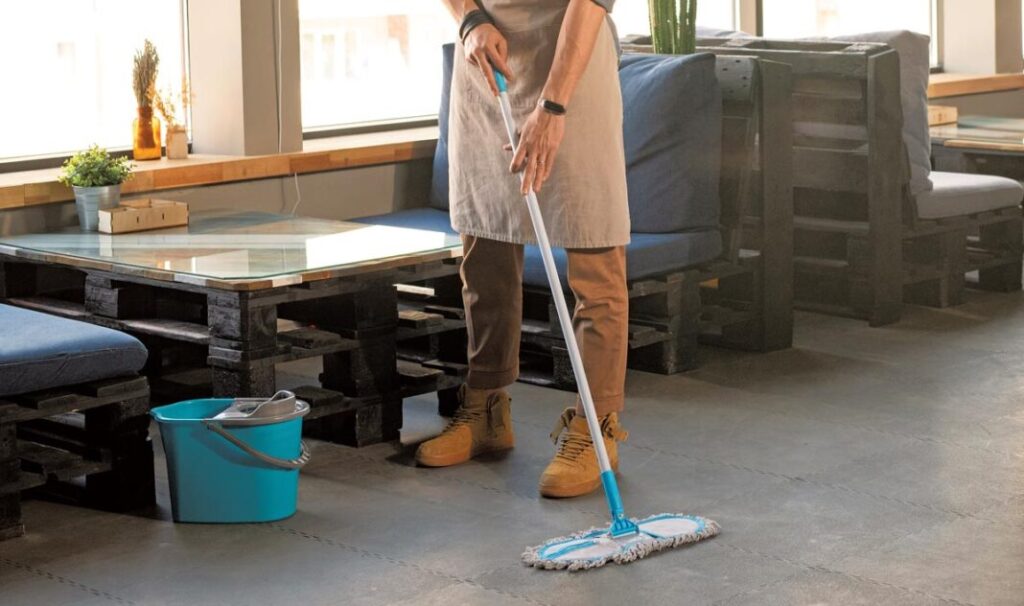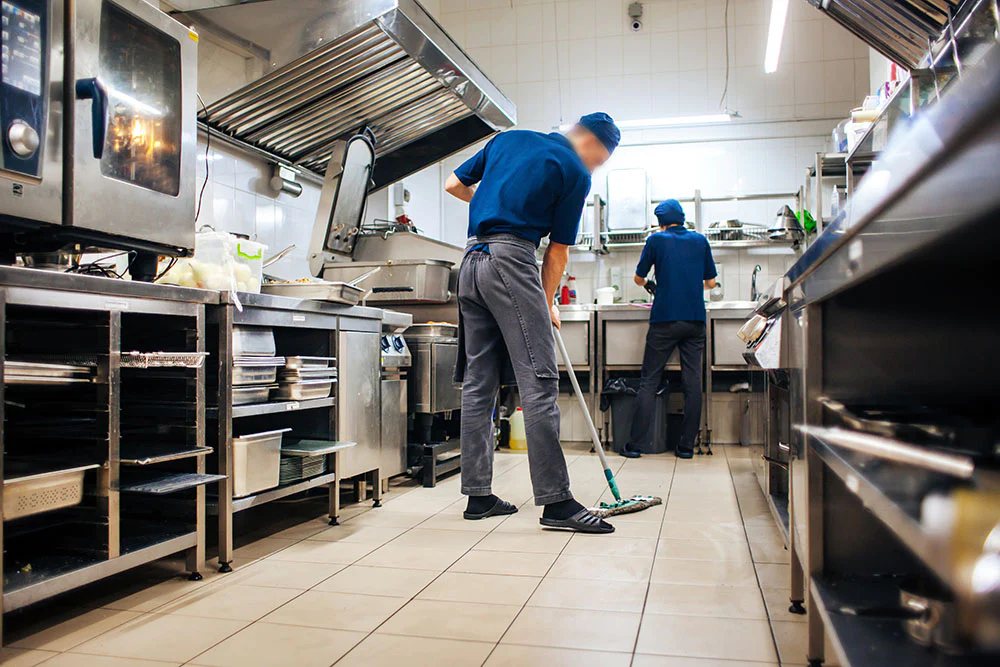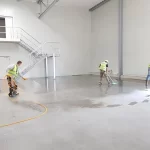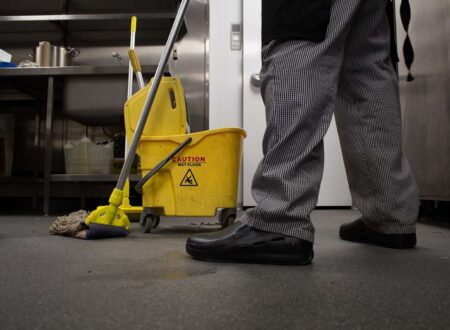Restaurant kitchen floor cleaning and degreasing Checklist:
Restaurant kitchen floor cleaning is not as simple as it sounds. Not only are there greasy messes, drink spills and food stains to deal with, but designers often carve out restaurant zones by specifying different flooring materials. This means there could be carpet in the front of the house, wood flooring in the bar, sealed concrete in the dining area and a tile and grout commercial kitchen floor with ceramic tile.
Does your staff know how to maintain each material properly?
Getting it wrong can damage expensive finishes, devastate your reputation and hurt the bottom line. Fortunately, Corporate Clean LLC has the right equipment, tools and techniques to make restaurant floor cleaning fast, complete and easy.
Read on for a list of common restaurant flooring types and cleaning methods.
Restaurant kitchen floor cleaning and degreasing Checklist:
Restaurant kitchen Carpet cleaning
Designed to stand up to heavy traffic and tough stains, restaurant carpet lends a touch of luxury to a dining area. The material feels great underfoot, adds traction and offers acoustical dampening. Follow these tips to keep the material looking great season after season.
- Spot clean spills immediately: Accidents happen, but ignoring drinks spilled on carpet is a big mistake. Yes, industrial carpet is designed to repel liquids but an unattended spill will eventually soak in and leave a stain.
- Pick up crumby, solid messes: Messy eaters, think babies, can leave a trail of crumbs in their wake. Clean those crumbs up to avoid tracking the mess throughout the space and grinding food solids into carpet fiber.
- Vacuum carpets daily or more: A very busy dining room may need vacuuming several times a day to keep carpet looking fresh. Choose off times to vacuum the whole carpeted space.
- Deep clean and degrease: Grease removal is vital for restaurant carpet maintenance. Set up a schedule for deep cleaning that includes a strategy for removing grease.

Concrete Floors cleaning-Restaurant kitchen floor cleaning
Designers who seek a special look will find sealed concrete to be an excellent option, due to its popularity, affordability, and lasting strength. Moreover, this material can be easily stained, textured or painted. Sealed concrete is also widely used in commercial kitchens because it fits seamlessly with drains and walls.
To clean concrete floors with Corporate Clean LLC. Floors will be clean, grease free and dry.
Ceramic Tile floor Cleaning
Ceramic tile and grout are a restaurant mainstay, and for good reason. The combination is highly durable, offers great traction and performance and is easy to maintain. A seemingly endless variety of colors and sizes means tile and grout floors can be found throughout the restaurant space, from the front entryway to the dining room and especially in the kitchen and restroom.
Cleaning tile and grout looks easy but beware—grout is quite porous and will absorb dirt, grease and pathogens. Cleaning with a mop and bucket makes the problem worse as the tile acts like a tiny squeegee, drawing dirty water out of the mop and depositing it on the porous grout. The result is dirty tile held together with discolored, malodorous grout. Sound appetizing?
How to Keep a Kitchen Floor Clean
Use a SqueegeeWhen it comes to removing caked-on dirt and grime, a squeegee can be an effective solution. Mops loosen and absorb dirt while a squeegee can peel away more stubborn pieces that don’t budge with mopping. Using cleaning fluid to soften the dirt beforehand helps, but often a squeegee alone is all you need. When your floor cleaning routine is complete, use the squeegee to wipe away any residual mop water or moisture from tiles and guide it into the drains. The two tools go hand in hand; one cleans, the other wipes.
Restaurant kitchen floor -Clean Once or Twice Daily
The kitchen floor of a restaurant must be scrubbed daily, and if the business operates over multiple hours in one day, this should be done twice. Moreover, to ensure deep cleanliness every four to seven days, the surface should be buffed with a 20-inch cleaning device equipped with a scrub pad that can spin at 175 rotations per minute.
The purpose of this special, more intense cleaning ritual is to loosen the types of harder, stickier gunk that can accumulate in spite of daily mopping. The floor cleaner should be long enough to buffer the floor with relative ease, but also narrow enough to reach as many spots as possible. The benefits are often most felt in narrow and harder-to-access areas that aren’t always reached by a mop or squeegee.

Keep All Cleaning Devices Properly Stored
Another key component of sanitation in the food service environment is proper storage for all cleaning devices. When mops and buckets aren’t properly stored, lingering dirt and fluid smells can aerosolize and spread to more vulnerable places — namely, the food-prep area. The fact is, cleaning devices need to be stored in a back room or closet where things are kept away from the foods or cooking devices.
Use Mats-Restaurant kitchen floor cleaning
To ensure employee safety after each mopping session, the walking and standing spaces along kitchen tiles should be covered with anti-fatigue mats. This makes things safer for kitchen personnel, because the mats prevent slips and falls during food prep. Of course, the mats must be cleaned at the end of each day, and preferably hung-dry to prevent water absorption.
Use Proper Cleaning Formulas
When a cleaning formula is advertised to work on all surfaces, chances are good it’s an inadequate product for kitchen floors in foodservice establishments. The problem comes down to the porous nature of quarry tiles, which — unlike kitchen counters and appliances — tend to attract thicker layers of grease.
Therefore, it’s best to avoid general cleaning products, and instead choose high-grade cleaners that are specifically formulated for kitchen floors.
Using a high-quality kitchen floor cleaner is essential; common errors in restaurants involve cleaning tiles with inadequate products like bleach or dishwashing detergent. The latter option is particularly hazardous as detergents contain lard, making the surface of the tile much more slippery.
Restaurant kitchen floor cleaning and degreasing Checklist-Corporate Clean LLC:
A clean kitchen is one of the key elements to a sanitary restaurant. That said, the labor required to maintain a kitchen floor can often be strenuous and time-consuming, particularly in fast-paced eating establishments where remnants constantly fall and dirty the tiles.
In everything from restaurants and bars to hotels and wineries, we leave kitchen floors looking spotless. To find out more about the types of cleaning we offer, click on over to our services page today!





2 Comments